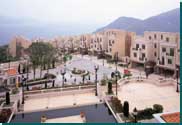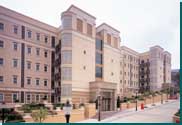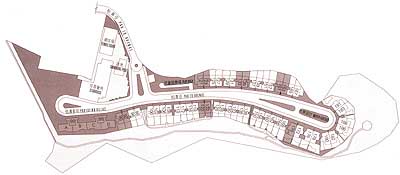| June
2000 |

 |
|
|
The Portofino
Headland
retreat
Sipping a pina colada
by a pool with a sweeping view of the cove where the odd boat briefly
sails before disappearing round the headland, one perhaps would
be forgiven for believing oneself being on a resort island off Greece.
But then the mobile phone rings, business beckons, and it's
back to work in Central
in half an hour or so. Is it possible that such a hideaway exists
in densely populated Hong Kong, and only a short drive away from
the busy central business district? It is, but, as the architect
would tell you, turning it into reality was by no means easy
 The
Portofino is a luxury residential development which contains 52
townhouses and 22 apartments located along the ridge of a headland
in scenic Clearwater Bay. It occupies a two-hectare site belonging
to the Hong Kong Adventist College, which used it to accommodate
staff quarters. Given the site's
development potential, the college was persuaded to enter into a
land exchange agreement under which it would surrender the site
for development by a private developer. The
Portofino is a luxury residential development which contains 52
townhouses and 22 apartments located along the ridge of a headland
in scenic Clearwater Bay. It occupies a two-hectare site belonging
to the Hong Kong Adventist College, which used it to accommodate
staff quarters. Given the site's
development potential, the college was persuaded to enter into a
land exchange agreement under which it would surrender the site
for development by a private developer.
Commanding a view of
Port Shelter where the scene's
tranquility is not upset by the presence of any other building and
the calm of the sea often gives it the illusion of a lake, the site
seemed ideal for a luxury residential project. It was some time,
however, before the necessary rezoning was achieved. Even then,
a number of restrictions were imposed by the Planning and District
Lands departments to ensure that the natural beauty of the area
would not be destroyed.
Though stipulated by
different departments, these restrictions nevertheless had an impact
on each other and the development as a whole. Thus, the architect,
Ronald Lu & Partners, was presented with a challenge to come
up with a design which would not only please the client and prospective
buyers, but also the wishes of the respective government departments.
The Planning Department's
primary concern was
for the retention of the rural character of the setting. It was
determined that the development should not have any adverse visual
impact on its surrounding, even though the townhouses would only
be three storeys high. The department required that the project
follow the site's
natural topography as far as possible, which meant the structures
would have to step down towards the sea along a steep incline.
Stilt structures would
normally be used to overcome the gradient differences, but concern
expressed by the District Lands department for possible misuse of
the void underneath such structures ruled them out as a solution.
In order to comply with
the two departments' demands, the architect decided to lower the
development's
profile by suppressing the structures of some townhouses near the
headland. This presented certain layout difficulties, in particular
the location of the garage at a level above the living quarters,
but gave the development a more interesting massing.
As a luxury low-rise
residential project, it was assumed that the occupants of each townhouse
would have direct access to their cars in garages attached to their
homes, even though a separate car park would also be provided. Providing
this convenience proved another challenge, as the architect had
to match the gentler gradient of the private road, which the Transport
Department required to be in line with its standards for all private
roads; with that of the houses, which follow the steeper gradient
of the natural slope.
The architect's
solution was to design
a 7.3 m wide road with a skewed 3 m wide pavement or transitional
zone which enables cars to be manoeuvred into the garages without
sustaining scratches to their undercarriages.
Due to the setting, the
Portofino was designed with a Meditarranean feel with pastel colours,
cast iron railings and lampposts, balustrades and other features
intended to evoke the same atmosphere an occupant is likely to derive
from the Italian fishing port from which the development took its
name.
Although a Meditarranean
atmosphere pervades the development, individual houses do have a
character of their own. Appreciating people's
preferences for homes
with unique identities, the architect took the variation-on-a-theme
approach towards the houses' architecture, blending slightly different
designs into a unified whole.
The development features
five types of townhouses which range in size from 3,339 sq ft to
4,413 sq ft. There are two or three elevation designs for each house
type, with different cast iron railings and entrance gates; curved,
flat or pointed entablatures; and alternating curved and triangular
roof features. They are painted in three different colours: cream,
beige and light pink. The marble chips coating as well as fibre
reinforced polyester and granite mouldings for the external walls
were put on elaborate mock-ups set up by the architect on site,
to make sure the colours would blend well together.
These townhouses are
designed for indulgence, especially for the master of each house
-- the bathroom of each master bedroom features a bathtub oriented
to capture an unobstructed seaview. More natural light is provided
by a skylight with a special glazing which permits a clear view
from within but a frosted appearance when viewed from outside.
All the townhouses were
designed to capture the Mediterranean outdoors, with setbacks providing
bedrooms on different levels with balconies and gardens on the ground
floor. In a Hong Kong first, each house also boasts a truly decadent
luxury -- an open jacuzzi on the roof with wooden decking, also
oriented to capture the full seaview. Ten of the largest houses
also have private swimming pools. These are located at the lowest
edge of the development, where the swimming pools extend out towards
the sea, thus giving their users a sense of private, undisturbed
freedom.
For residents without
their own swimming pools, the Portofino has a clubhouse with a resort-style
swimming pool which, again, is oriented to provide a visual link
with the sea beyond the balustrade and other classical architectural
features. Other facilities include a gymnasium, a children's
playroom, a snooker
room and a multipurpose room.
According to Ronald Lu,
managing director of Ronald Lu & Partners, the 1,000 sq m clubhouse
was set into the hillside near the top of the development to mask
the presence of a satellite uplink station with its visually disruptive
cluster of satellite dishes. Another thoughtful use of massing is
the location of a children play area to the north of the clubhouse,
where the retention of existing trees allows the architect to cover
the cable provisions for the development.
This attention to detail
has ensured that the Portofino provides an exceptional living environment
in an exotic setting which has to be experienced to be believed.

developer Cheung Kong
(Holdings)
architect Ronald Lu & Partners (HK) Ltd
contractor Hien Lee Engineering Co Ltd
structural engineer T K Tsui & Associates
m&e engineer J Roger Preston Ltd
landscape designer ACLA Ltd
quantity surveyor Levett & Bailey
|

 The
Portofino is a luxury residential development which contains 52
townhouses and 22 apartments located along the ridge of a headland
in scenic Clearwater Bay. It occupies a two-hectare site belonging
to the Hong Kong Adventist College, which used it to accommodate
staff quarters. Given the site's
development potential, the college was persuaded to enter into a
land exchange agreement under which it would surrender the site
for development by a private developer.
The
Portofino is a luxury residential development which contains 52
townhouses and 22 apartments located along the ridge of a headland
in scenic Clearwater Bay. It occupies a two-hectare site belonging
to the Hong Kong Adventist College, which used it to accommodate
staff quarters. Given the site's
development potential, the college was persuaded to enter into a
land exchange agreement under which it would surrender the site
for development by a private developer.